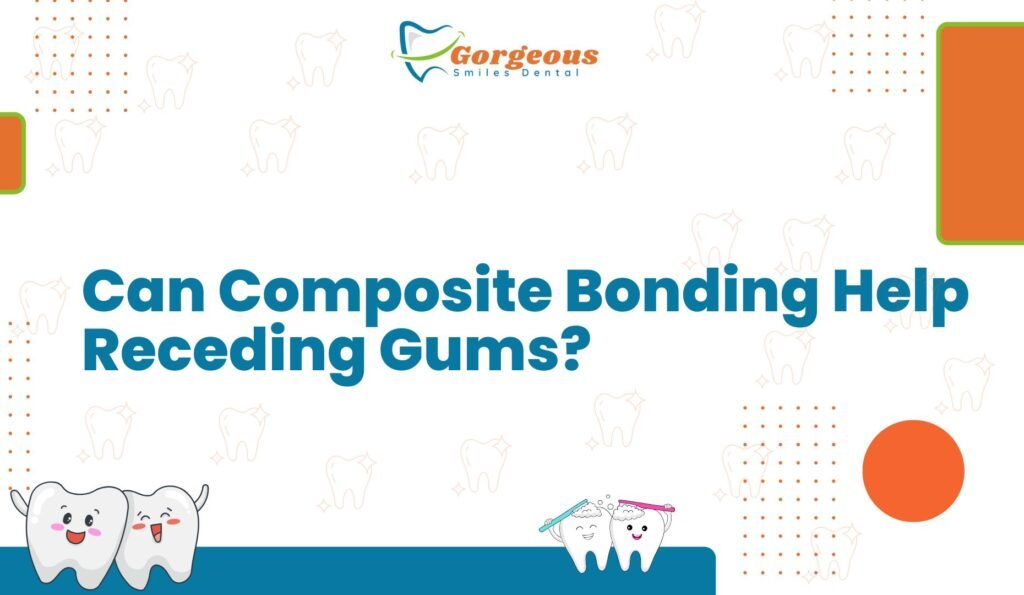Can Composite Bonding Help Receding Gums?

Receding gums can change the look of your smile and expose the roots of your teeth, making them sensitive and vulnerable. Many people look for fast cosmetic solutions that can restore confidence without complex surgery. One common question is whether composite bonding can help improve the appearance of receding gums. The short answer is yes — but only in specific situations. Bonding is not a cure for gum recession, but it can mask the defects, protect exposed roots, and create a balanced smile.
This detailed guide explains how composite bonding, also known as dental bonding, works, when it can help, when it cannot, and what alternatives you may need. By the end of this article, you’ll know exactly when bonding is the right choice and when other gum treatments are better.
Understanding Gum Recession
Gum recession happens when the gum tissue pulls away from the teeth and exposes the roots. This can occur slowly over time and is often painless at first, making it easy to miss.
Why Gum Recession Happens
Several factors can lead to recession, including:
- Aggressive brushing
- Gum disease
- Genetics
- Aging
- Teeth grinding
- Misaligned teeth
- Trauma to the gum tissue
Each cause requires a different approach to treatment.
Symptoms of Receding Gums
Some common signs include:
- Tooth sensitivity
- Longer-looking teeth
- Visible root surfaces
- Dark gaps or uneven gum lines
- Food getting trapped between teeth
Why Receding Gums Need Treatment
Untreated recession increases the risk of:
- Tooth decay
- Gum infections
- Tooth mobility
- Loss of tooth support
- Uneven smile appearance
That’s why many patients look for ways to improve both the function and the appearance of their teeth.
What Is Composite Bonding?
Composite bonding is a cosmetic dental treatment that uses tooth-colored resin to reshape and restore teeth. It blends with the natural tooth color and can correct chips, cracks, gaps, and surface irregularities.
How Composite Bonding Works
The dentist applies a soft resin to the tooth, shapes it by hand, and hardens it with a curing light. The material bonds securely to the enamel and becomes part of the tooth structure.
Why Composite Bonding Is Popular
People choose composite bonding because it is:
- Minimally invasive
- Affordable
- Fast
- Painless
- Natural-looking
Bonding is especially useful for cosmetic enhancements and protecting exposed tooth surfaces.
Can Composite Bonding Fix Receding Gums?
This is where it gets interesting. Composite bonding cannot regrow gum tissue, but it can improve how your teeth look when gums recede. It can also protect exposed roots from sensitivity and wear.
What Bonding CAN Do for Receding Gums
Bonding can:
- Cover exposed root surfaces
- Mask the dark appearance near the gumline
- Rebuild the tooth shape to blend with receded areas
- Reduce sensitivity caused by exposed root dentin
- Improve smile harmony
What Bonding CANNOT Do
Bonding cannot:
- Restore lost gum tissue
- Treat gum disease
- Stop recession caused by bone loss
- Replace surgical gum grafting when needed
This means bonding is a cosmetic and protective solution — not a medical cure.
When Bonding Is a Good Option
Bonding works best when:
- Recession is mild to moderate
- The patient wants cosmetic improvement
- There is root sensitivity
- Gum health is stable and under control
For patients not ready for gum grafting, bonding is a helpful short-term or medium-term solution.
How Composite Bonding Helps Improve Smile Aesthetics
Many patients choose composite bonding because gum recession often makes teeth look longer or uneven. Bonding helps reshape the tooth and restore balance.
Masking Root Exposure
Exposed roots often look darker or yellower than enamel. Bonding covers these areas with a natural-colored layer.
Creating the Illusion of a Fuller Gumline
By adding material near the gumline, the tooth appears shorter and more proportionate.
Smoothing Abrasion Marks
Aggressive brushing can wear down tooth surfaces. Bonding smooths and protects these worn areas.
Improving Tooth Color and Symmetry
When gum recession affects multiple teeth, the smile can look uneven. Bonding creates a more even, youthful appearance.
Composite Bonding vs. Gum Grafting
Patients often wonder whether they should choose bonding or gum grafting. Both treatments have different goals.
What Gum Grafting Does
Grafting replaces lost gum tissue using donor tissue from the palate or a synthetic membrane. It is ideal for:
- Moderate to severe recession
- Gum disease–related recession
- Protecting tooth roots from further damage
When Gum Grafting Is Necessary
Grafting is necessary when:
- Bone loss is present
- Teeth have mobility
- Recession is progressing
- The roots are significantly exposed
Why Some Patients Prefer Bonding First
Not everyone wants surgery. Bonding offers:
- No downtime
- Immediate results
- Lower cost
- No surgical discomfort
In some cases, dentists may recommend bonding after grafting to perfect the final appearance.
Does Composite Bonding Protect Teeth Affected by Recession?
Yes — this is one of its biggest benefits.
Protecting the Exposed Root Surface
The root surface is softer than enamel and wears down quickly. Bonding adds a protective shield to prevent erosion.
Reducing Tooth Sensitivity
Many patients feel sensitivity to cold, sweet, or acidic foods when gums recede. Bonding seals the root and reduces this discomfort.
Preventing Further Damage
Bonding can stop long-term wear, especially for patients who grind their teeth or brush aggressively.
Composite Bonding for Receding Gums: The Procedure
Understanding the bonding process helps patients know what to expect.
Step 1 — Gum Health Evaluation
Bonding should only be performed when gum disease is under control. If inflammation or infection is present, the dentist treats these issues first.
Step 2 — Shade Matching
The dentist selects a resin shade that perfectly matches your natural enamel.
Step 3 — Tooth Preparation
In most cases, no drilling is required. The tooth is cleaned and lightly etched to help the resin stick.
Step 4 — Composite Application
The dentist applies the composite resin in layers and shapes it by hand.
Step 5 — Curing
A special light hardens the resin instantly.
Step 6 — Polishing and Finishing
The tooth is polished to blend the bonding seamlessly with the natural tooth.
Most appointments take 30–60 minutes per tooth.
How Long Composite Bonding Lasts With Receding Gums
Composite bonding usually lasts several years, but its lifespan depends on your oral habits, gum health, and maintenance. Proper care helps the bonding stay strong and natural-looking.
Average Lifespan
Composite bonding usually lasts:
- 5 to 7 years with proper care
- Sometimes longer depending on habits
Factors That Affect Longevity
Bonding lasts longer when:
- Gum disease is stable
- The patient avoids aggressive brushing
- Teeth are protected from grinding
- Oral hygiene is excellent
Maintenance Requirements
Bonding may need occasional:
- Polishing
- Touch-ups
- Repairs if chipped
Conclusion
Composite bonding can be a helpful solution for people with receding gums, especially when the goal is to improve appearance, reduce sensitivity, and protect exposed roots. While bonding doesn’t cure gum recession or replace surgical treatments, it offers a safe, comfortable, and affordable way to restore confidence in your smile. For mild to moderate recession, bonding blends beautifully with natural teeth and gives you a healthier, more even look. The key is choosing a skilled dentist who understands gum health, cosmetic techniques, and long-term maintenance.
If you’re exploring whether bonding or another treatment is right for you, speak with an experienced Dentist in Springfield, MA who can guide you toward the best option for your smile.
FAQs
Can composite bonding fix receding gums?
Bonding cannot regrow gum tissue, but it can improve the appearance of recession and protect exposed roots.
Does bonding help with sensitivity caused by gum recession?
Yes. Bonding seals the root surface and reduces sensitivity from cold, sweet, or acidic foods.
Is bonding permanent for receding gums?
Bonding is long-lasting but not permanent. It usually lasts 5 to 7 years and may need touch-ups over time.
Can bonding be done on every tooth with recession?
It depends. If the recession is severe or the root surface is too exposed, bonding may not adhere well, and grafting might be recommended.
Is gum grafting better than composite bonding?
Gum grafting is better for restoring lost gum tissue. Bonding is better for cosmetic improvement and sensitivity relief.
Does composite bonding work if I have gum disease?
No. Gum disease must be treated first before bonding is done.
How long does the bonding procedure take?
Most bonding appointments take 30–60 minutes per tooth.
Will bonding stain?
Composite can stain over time, especially with coffee, wine, tea, or tobacco.
Can bonding be combined with gum grafting?
Yes. Many patients graft first, then bond to perfect the final shape.
Does bonding require drilling?
Very little or no drilling is needed for bonding near the gumline.
Ready to book an appointment?
Book a consultation today or make an appointment using our convenient online appointment scheduler.

We’re committed to your safety.
Enjoy the flexibility of paying through monthly payments.

A discount plan available to keep you and your family healthy.
Others Article
At our dental practice, we prioritize compassion and empathy toward our patients. Please read our blog and articles for tips on maintaining oral health and learn more about our commitment to providing exceptional dental care with a personal touch.
